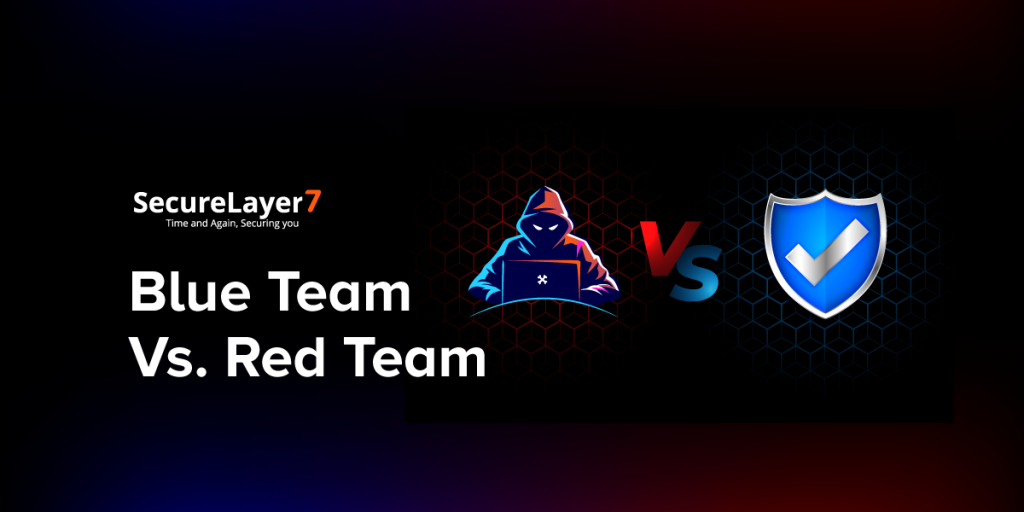
HTTP Parameter Pollution
April 20, 2023
Server-side Request Forgery (SSRF) via DNS Rebinding Attack
April 25, 2023
In cybersecurity, two important teams protect an organization’s assets and data: the Red and Blue teams.
The Red Team is responsible for testing an organization’s security defenses by attempting to penetrate them, while the Blue Team is responsible for detecting and responding to these attacks.
These teams work together to provide a comprehensive approach to cybersecurity, but they have distinct roles and responsibilities.
In this blog post, we’ll explore the differences between the Red Team and Blue Team in cybersecurity, their respective objectives, and the importance of their collaboration in securing an organization’s assets.
Red Team vs Blue Team

Red Team vs Blue Team is a concept commonly used in cybersecurity to refer to two opposing teams that work together to improve an organization’s security posture.
The Red Team is the offensive team, tasked with attempting to penetrate the organization’s defenses and find vulnerabilities. The Blue Team is the defensive team, responsible for detecting and responding to these attacks.
Red Team vs Blue Team exercises can be conducted in a variety of ways, including tabletop exercises, penetration testing, and full-scale cyber-attack simulations. These exercises help organizations identify weaknesses in their security defenses, as well as test their incident response plans.
What is a Red Team?
Red Team is a group of security professionals who are tasked with simulating an attack on an organization’s security infrastructure. The Red Team’s objective is to identify vulnerabilities in the organization’s security posture and report them to the Blue Team for remediation.
Red Team exercises are designed to mimic the tactics, techniques, and procedures that real-world attackers might use to compromise an organization’s systems and steal sensitive information.
This can include techniques such as social engineering, phishing, physical intrusion, network penetration, and exploitation of software vulnerabilities.
The Red Team operates under the assumption that they are sophisticated and motivated attackers who are determined to breach the organization’s security defenses. This requires them to be highly skilled and knowledgeable in a wide range of tools, techniques, and procedures used by real-world attackers.
Red Team exercises are often conducted in a controlled environment, using methodologies such as penetration testing or ethical hacking. The objective is to simulate a real-world attack scenario and assess the effectiveness of the organization’s security defenses in detecting and responding to the attack.
How Does Red Teaming Work?
Red teaming works by simulating an attack on an organization’s security infrastructure using the same tools, tactics, and procedures that real-world attackers might use.
They’re made up of highly skilled security professionals who are tasked with finding weaknesses in the organization’s defenses.
The objective of the Red Team is to gain unauthorized access to sensitive data, systems, or applications and report their findings to the organization’s security team.
They may use a variety of techniques, such as social engineering, phishing, or network penetration, to gain access to the organization’s systems.
Why Does Your Security Need Red Teaming?
Red teaming is an essential part of a comprehensive security strategy for any organization. It provides an unbiased and objective assessment of an organization’s security defenses by simulating a real-world attack scenario.
This helps identify gaps in the organization’s security posture and allows security teams to improve their policies, procedures, and technologies.
Red teaming can help organizations stay one step ahead of attackers by identifying and addressing vulnerabilities before they can be exploited.
Examples Of Red Team Exercises:
- Penetration Testing: In this type of exercise, the Red Team attempts to gain unauthorized access to the organization’s systems and data by exploiting vulnerabilities in the security infrastructure. The objective is to identify weaknesses in the organization’s defenses and report them to the Blue Team for remediation.
- Social Engineering: Social engineering is the practice of manipulating individuals to gain access to sensitive information or systems. The Red Team may use tactics such as pretexting, phishing, or baiting to trick employees into giving up their login credentials or other sensitive information.
- Physical Intrusion: In this type of exercise, the Red Team attempts to gain unauthorized physical access to the organization’s facilities. This can include gaining access to restricted areas or stealing sensitive documents.
- Red Team vs Blue Team: In this type of exercise, the Red Team and the Blue Team work together in a simulated attack scenario. The Red Team attempts to breach the organization’s security defenses, while the Blue Team attempts to detect and respond to the attack.
See Also – You can learn more about Penetration Testing here.
What is a Blue Team?
A Blue Team is a group of cybersecurity professionals within an organization responsible for defending against cyber attacks. The primary goal of a Blue Team is to identify and respond to cyber threats and vulnerabilities in an organization’s systems and network.

They work to detect and prevent cyber attacks by monitoring network traffic, analyzing system logs, and managing security technologies such as firewalls, intrusion detection/prevention systems, and endpoint protection.
Blue Team members may also conduct vulnerability assessments, penetration testing, and tabletop exercises to identify weaknesses in the organization’s security posture and develop strategies to mitigate risk.
They work closely with other teams within the organization, such as IT and Security Operations Centers (SOCs), to ensure a coordinated response to any security incidents.
In essence, the Blue Team’s role is to proactively defend an organization’s assets against cyber threats, protect sensitive data, and maintain business continuity. They play a crucial role in ensuring the organization’s overall security posture is resilient and effective against a range of cyber threats.
How does blue teaming work?
Blue teaming involves using defensive measures to detect, prevent, and respond to cyber threats. The team may use a variety of tools and techniques, such as intrusion detection systems, firewalls, and penetration testing, to assess the security of an organization’s systems.
Why does your security need blue teaming?
Your security needs blue teaming because it provides an essential layer of defense against cyber threats. With the increasing sophistication of attacks, it is no longer sufficient to rely solely on traditional security measures. Blue teaming is a proactive approach to cybersecurity that can help organizations stay ahead of threats.
Examples of blue team exercises include:
- Tabletop exercises: These are simulations of cybersecurity incidents that allow blue teams to practice their response to potential threats.
- Vulnerability Assessment and Patch Management: The Blue Team conducts regular vulnerability assessments to identify vulnerabilities in systems, networks, and applications. They prioritize the vulnerabilities based on severity and patch them accordingly. This exercise helps the Blue Team identify vulnerabilities that could potentially be exploited by attackers and proactively address them through timely patching.
- Incident Response Drills: The Blue Team conducts incident response drills to practice their response procedures in the event of a security breach or cyber-incident. This includes activities such as identifying and containing the incident, preserving evidence, conducting forensic analysis, and restoring normal operations. This exercise helps the Blue Team improve their incident response capabilities, identify areas for improvement, and ensure that their response procedures are effective.
Benefits Of Red Team vs Blue Team Exercises
Here are 5 main benefits of Red Team vs Blue Team exercises.
- Identifying Vulnerabilities
- Testing Defense Mechanisms
- Enhancing Incident Response Capabilities
- Enhancing Communication and Coordination
- Raising Security Awareness
1. Identifying Vulnerabilities
Red Team vs Blue Team exercises allow organizations to identify vulnerabilities in their systems, networks, and applications by simulating realistic attack scenarios. This helps the Blue Team identify weaknesses in their defenses and understand how attackers could potentially exploit them.
2. Testing Defense Mechanisms
Red Team vs Blue Team exercises allow organizations to test their defense mechanisms, including intrusion detection systems (IDS), firewalls, and other security controls, in a controlled environment.
This helps the Blue Team evaluate the effectiveness of their current security measures and make improvements based on the findings.
3. Enhancing Incident Response Capabilities
Red Team vs Blue Team exercises provide opportunities for the Blue Team to practice their incident response procedures and improve their capabilities in detecting, responding to, and mitigating cyber-attacks.
This helps organizations fine-tune their incident response plans and ensure that their teams are well-prepared to handle real-world security incidents.
4. Enhancing Communication and Coordination
Red Team vs Blue Team exercises promote communication and coordination between the Blue Team members during simulated cyber-attacks. This helps teams develop better collaboration and response strategies and improves their ability to work together under pressure during a real cyber incident.
5. Raising Security Awareness
Red Team vs Blue Team exercises raise security awareness among employees by showcasing the potential risks and impacts of cyber-attacks.
This helps organizations educate their employees about common threats, best practices, and the importance of following security protocols, leading to a more security-conscious culture within the organization.
How Do The Two Teams Work Together?
The Red Team and Blue Team work together in a collaborative manner during a Red Team vs Blue Team exercise to simulate realistic cyber-attack scenarios and evaluate the effectiveness of the organization’s defenses.
Here’s how the two teams typically work together.
1. Red Team (Adversary)
The Red Team, also known as the “adversary,” is a team of ethical hackers who simulate real-world attackers.
They attempt to exploit vulnerabilities, gain unauthorized access, and achieve specific objectives (e.g., access sensitive data, disrupt operations, etc.) in a controlled and authorized manner.
The Red Team employs various tactics, techniques, and procedures (TTPs) commonly used by actual attackers to challenge the organization’s defenses.
2. Blue Team (Defenders)
The Blue Team, also known as the “defenders,” is the internal security team responsible for defending the organization’s systems, networks, and applications.
They actively monitor and respond to the simulated attacks initiated by the Red Team, using their security tools, techniques, and procedures to detect, analyze, and respond to the Red Team’s TTPs.
The Blue Team’s goal is to identify and mitigate the Red Team’s attacks, protect the organization’s assets, and minimize the impact of the simulated cyber incident.
3. Collaboration and Coordination
During a Red Team vs Blue Team exercise, the two teams work together in a collaborative manner. They may communicate and coordinate their actions to simulate a realistic cyber incident and response.
For example, the Red Team may use various TTPs to attempt to bypass the Blue Team’s defenses. At the same time, the Blue Team responds by detecting and analyzing the Red Team’s activities, containing the incident, and implementing appropriate countermeasures.
4. Learning and Improvement
The Red Team vs Blue Team exercise provides an opportunity for both teams to learn and improve.
The Red Team helps the Blue Team by identifying vulnerabilities and weaknesses in the organization’s defenses, highlighting areas for improvement, and testing the effectiveness of the Blue Team’s incident response procedures.
The Blue Team, on the other hand, learns from the Red Team’s TTPs, strengthens their defenses, and enhances their incident response capabilities based on the findings from the exercise.
5. Post-Exercise Analysis
After the Red Team vs Blue Team exercise, both teams typically engage in a post-exercise analysis, also known as a “hot wash” or “after-action review.”
This involves reviewing the results, discussing the tactics used, identifying lessons learned, and developing action plans to address vulnerabilities and improve defenses.
The Red Team and Blue Team may collaborate to implement necessary changes and improvements based on the findings from the exercise.
What is a Purple Team?
The purple team is a combination of both red and blue teams. The purple team works together to simulate attacks, test defenses, and identify vulnerabilities in an organization’s systems.
This approach allows for more collaboration between the two teams and can lead to more effective cybersecurity measures.
The Purple Team is a concept that combines elements of both the Red Team and Blue Team approach, but it operates differently from the traditional Red Team and Blue Team roles. Here are some key differences.
1. Collaboration
While the Red Team and Blue Team often operate in an adversarial relationship, with the Red Team simulating attacks and the Blue Team defending against them, the Purple Team focuses on collaboration.
The Purple Team works closely together as a single unit, with members from both the Red Team and Blue Team collaborating and sharing knowledge and expertise throughout the exercise.
2. Shared Goals
Unlike the traditional Red Team vs Blue Team approach where the Red Team’s goal is to find vulnerabilities and exploit them, and the Blue Team’s goal is to defend against the Red Team’s attacks, the Purple Team shares common goals.
The Purple Team works together to identify vulnerabilities, test defenses, and improve overall security posture, with a focus on joint learning and improvement.
3. Real-Time Feedback
In a Purple Team exercise, real-time feedback is provided to the Red Team by the Blue Team, and vice versa.
This allows for an immediate exchange of information, lessons learned, and insights, enabling the teams to work collaboratively to identify and address vulnerabilities, enhance defenses, and improve incident response capabilities in real-time.
4. Active Participation
In a Purple Team exercise, both the Red Team and Blue Team are actively involved in the process, with a focus on continuous improvement. The teams actively share information, analyze attacks, and work together to identify and address weaknesses in the organization’s defenses.
5. Joint Analysis and Remediation
The Purple Team engages in joint analysis and remediation activities. After each simulated attack, the Purple Team reviews the findings together, analyzes the attack techniques used, and collaboratively develops strategies to remediate vulnerabilities and improve defenses.
This joint analysis and remediation approach helps to bridge the gap between offensive and defensive cybersecurity practices.
Get Access to Your Own Red Team with Securelayer7
Are you concerned about the security of your organization’s systems and network? Are you aware that traditional security measures may not be enough to defend against sophisticated attacks?
At Securelayer7, we offer Red Team services that can help you identify vulnerabilities in your organization’s security posture before they can be exploited by real attackers.
Our team of cybersecurity professionals will simulate real-world attacks on your organization’s systems and applications, including social engineering tactics, physical security assessments, and application security assessments.
By working with us, you will get access to a comprehensive assessment of your organization’s security posture, including an in-depth report of findings and recommendations for remediation.
Don’t wait until it’s too late. Get access to your own Red Team with Securelayer7 and stay one step ahead of the attackers. Contact us today to learn more.
